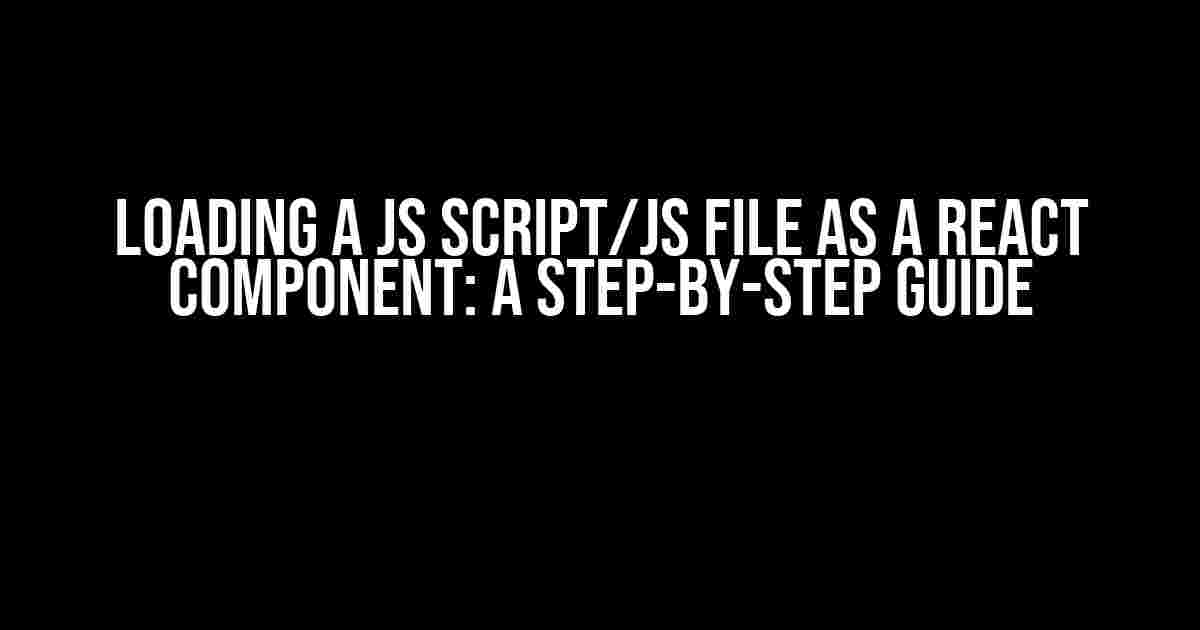Loading a JavaScript file as a React component might seem like a daunting task, especially for those new to the world of React. But fear not, dear reader, for we’re about to embark on a journey to conquer this challenge together! In this article, we’ll delve into the world of React components and explore the different ways to load a JavaScript script or file as a React component.
Why Load a JavaScript Script/JS File as a React Component?
Before we dive into the nitty-gritty of loading a JavaScript script or file as a React component, let’s take a step back and understand why we would want to do this in the first place. Here are a few reasons:
-
Reusability: By loading a JavaScript script or file as a React component, you can reuse the same functionality across multiple components, reducing code duplication and making your codebase more maintainable.
-
Modularity: Breaking down your application into smaller, independent components makes it easier to develop, test, and maintain.
-
Decoupling: By separating your JavaScript script or file from your React component, you can decouple the two and make it easier to update or replace either one without affecting the other.
Method 1: Using the Script Tag
The simplest way to load a JavaScript script or file as a React component is by using the script tag. This method is ideal for small scripts or files that don’t require any complex setup.
<script src="script.js"></script>In the above example, we’re loading a script file named `script.js` using the script tag. This method is straightforward, but it has some limitations. For instance, you can’t use ES6 imports or exports, and you can’t take advantage of React’s built-in features like JSX or React Hooks.
Method 2: Using the import Statement
Another way to load a JavaScript script or file as a React component is by using the import statement. This method is more flexible than the script tag and allows you to use ES6 imports and exports.
import script from './script.js';In the above example, we’re importing a script file named `script.js` using the import statement. This file can contain ES6 imports and exports, making it more powerful than the script tag method.
Method 3: Using a React Loadable
A React Loadable is a higher-order component (HOC) that allows you to load a JavaScript script or file dynamically. This method is ideal for larger scripts or files that require complex setup or have dependencies.
import Loadable from 'react-loadable';
const LoadableScript = Loadable({
loader: () => import('./script.js'),
loading: () => Loading...
,
});
const App = () => {
return (
In the above example, we’re using the `react-loadable` library to create a Loadable component that loads a script file named `script.js`. The `loader` function imports the script file, and the `loading` function returns a loading message while the script is being loaded.
Method 4: Using a Webpack Chunk
Webpack chunks are a way to split your code into smaller, independent modules that can be loaded dynamically. This method is ideal for large applications with complex dependencies.
import React from 'react';
import { BrowserRouter, Route, Switch } from 'react-router-dom';
const ScriptChunk = () => {
return (
);
};
const Script = () => {
return ;
};In the above example, we're using Webpack chunks to create a separate chunk for our script file. The `ScriptChunk` component loads the script file dynamically using the `Switch` and `Route` components from `react-router-dom`.
Conclusion
Loading a JavaScript script or file as a React component can be achieved using different methods, each with its own strengths and weaknesses. By understanding the pros and cons of each method, you can choose the best approach for your specific use case. Remember to consider factors like reusability, modularity, and decoupling when deciding how to load your JavaScript script or file as a React component.
Bonus: Best Practices for Loading JavaScript Scripts/Files as React Components
Here are some best practices to keep in mind when loading JavaScript scripts or files as React components:
-
Keep your scripts and files organized and structured. This will make it easier to maintain and update your codebase.
-
Use meaningful names for your scripts and files. This will make it easier to understand the purpose of each script or file.
-
Minimize dependencies and keep your scripts and files self-contained. This will make it easier to update or replace individual scripts or files without affecting the rest of your application.
-
Use React's built-in features like JSX and React Hooks to make your scripts and files more powerful and flexible.
-
Test your scripts and files thoroughly to ensure they work as expected. This will help catch any errors or bugs before they cause problems in your production application.
| Method | Pros | Cons |
|---|---|---|
| Script Tag | Simple, easy to use | Limited functionality, no ES6 imports/exports |
| Import Statement | Flexible, allows ES6 imports/exports | May require additional setup for larger scripts/files |
| React Loadable | Dynamically loads scripts/files, allows for complex setup | May require additional dependencies, can be complex to set up |
| Webpack Chunk | Allows for dynamic loading of scripts/files, ideal for large applications | May require complex setup, can be difficult to maintain |
By following these best practices and choosing the right method for your use case, you can load JavaScript scripts or files as React components with confidence and ease.
Final Thoughts
Loading a JavaScript script or file as a React component is a powerful technique that can help you create more maintainable, flexible, and reusable code. By understanding the different methods and best practices outlined in this article, you'll be well on your way to becoming a master of React component loading. Happy coding!
Here are 5 Questions and Answers about "Loading a js script js file as a React component" with a creative voice and tone:
Frequently Asked Question
Get answers to the most pressing questions about loading js scripts as React components!
Can I load a JavaScript file as a React component?
Yes, you can! You can import a JavaScript file as a React component using the `import` statement. For example, if you have a JavaScript file called `myScript.js`, you can import it into your React component like this: `import './myScript.js';`. This will load the script into your component.
How do I use a JavaScript file as a React component?
Once you've imported the JavaScript file, you can use it as a React component by rendering it in your component's JSX. For example, if your JavaScript file exports a function called `myFunction`, you can use it in your React component like this: `
`. This will render the output of the `myFunction` function in your component.
Do I need to wrap my JavaScript file in a React component?
No, you don't need to wrap your JavaScript file in a React component. However, if you want to use the JavaScript file as a reusable component, it's a good idea to wrap it in a React component. This will allow you to easily reuse the component in other parts of your application.
Can I pass props to a JavaScript file loaded as a React component?
Yes, you can pass props to a JavaScript file loaded as a React component. You can pass props to the component just like you would with any other React component. For example, if you have a JavaScript file that exports a function called `myFunction`, you can pass props to it like this: `
`. This will pass the `props` object to the `myFunction` function.
Are there any performance implications to loading a JavaScript file as a React component?
Loading a JavaScript file as a React component can have performance implications, especially if the file is large or contains complex logic. This is because the file will be loaded and executed every time the component is rendered. However, if you're careful about how you load and use the file, the performance impact can be minimized. For example, you can use lazy loading or memoization to reduce the performance impact.




